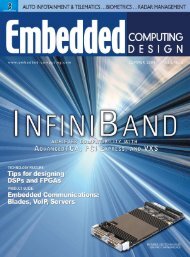VITA 46.9: Ensuring mezzanine I/O pinout interoperability for VPX ...
VITA 46.9: Ensuring mezzanine I/O pinout interoperability for VPX ...
VITA 46.9: Ensuring mezzanine I/O pinout interoperability for VPX ...
Create successful ePaper yourself
Turn your PDF publications into a flip-book with our unique Google optimized e-Paper software.
Hardware<strong>VPX</strong> ... Almost REDIThe mapping pattern X12d was a morecomplex challenge. The X12d maps12 differential pairs of the XMC Jn6connector to the RT2 connector. Theworking group chose 12 differential pairsas a good tradeoff between the amount ofXMC I/O mapped to the MultiGig RT-2connector versus the number of I/O linesleft over <strong>for</strong> use by the host card itself. Theworking group spent much time debatingthis mapping. The main issue was which12 pairs should be mapped? The XMCJn6 connector is an open field connectorarranged as 6 columns (A to G) and19 rows of pins, <strong>for</strong> a total of 114 pins.Much signal integrity work was done inthe XMC working group. It showed that20 differential pairs can be obtained byplacing them on the odd rows on columnsAB, DE with grounds on the even rows ofthose same columns. The XMC workinggroup further defined that rows 1,3,5,7were to be transmit lines and 11,13,15,17were to be receive lines. This approachprovides an XMC <strong>mezzanine</strong> card with theability to support up to eight lanes of serialtx/rx traffic. The working group decidedto stay with this pattern and allowed8 differential pairs <strong>for</strong> a fabric port onrows 1,3 and 11,13 and assigned theremaining 12 pairs <strong>for</strong> the X12d backplaneI/O pattern.The patterns X20d24s and X20d38s hencefell out from this ef<strong>for</strong>t once the X12dpattern was defined. The X20d24s patternmaps 20 pairs and 24 single-ended pinsfrom columns C and F to a single RT-2connector. The X20d38s pattern maps20 pairs and 38 single-ended pins fromcolumns C and F over two RT-2 connectors.Note that the X20d38s pattern maps78 pins to the RT-2 connector. This is thefull complement of pins on the 114 pinXMC connector as the rest are dedicatedto grounds.<strong>VITA</strong> <strong>46.9</strong> speeds futuredevelopmentBy ensuring that <strong>mezzanine</strong> I/O differentialpair mapping was defined in the<strong>VPX</strong> specification – and particularly<strong>VITA</strong> <strong>46.9</strong> – the <strong>VPX</strong> working group hasensured that <strong>mezzanine</strong>, basecard, andbackplane/chassis designers will have theproper in<strong>for</strong>mation to enable them to designinteroperable PMC and XMC I/O <strong>mezzanine</strong>cards. This will help ease the adoptionof new high-speed <strong>VPX</strong> and <strong>VPX</strong>-REDIapplications, paving a smoother pathto the future <strong>for</strong> the end users of today’schallenging applications. CSJing Kwok isprincipal engineerin the TechnologyGroup at Curtiss-Wright ControlsEmbeddedComputing. Hehas been involvedwith VMEbus standards work <strong>for</strong> thepast 15 years. He is editor of one ofthe <strong>VITA</strong> 46 “dot” specifications nowin working group ballot and was oneof the chapter editors <strong>for</strong> the VME64specification. Jing is a graduate ofthe British Columbia Institute ofTechnology.For more in<strong>for</strong>mation, contact Jing at:Curtiss-Wright ControlsEmbedded Computing333 Palladium Drive, m/s 385Kanata, ON, Canada K2V-1A6613-599-9199, Ext. 5825jing.kwok@curtisswright.comwww.cwcembedded.comForSinglePrintOnlyVME and Critical Systems ©2007 OpenSystems Publishing. Not <strong>for</strong> Distribution.
















